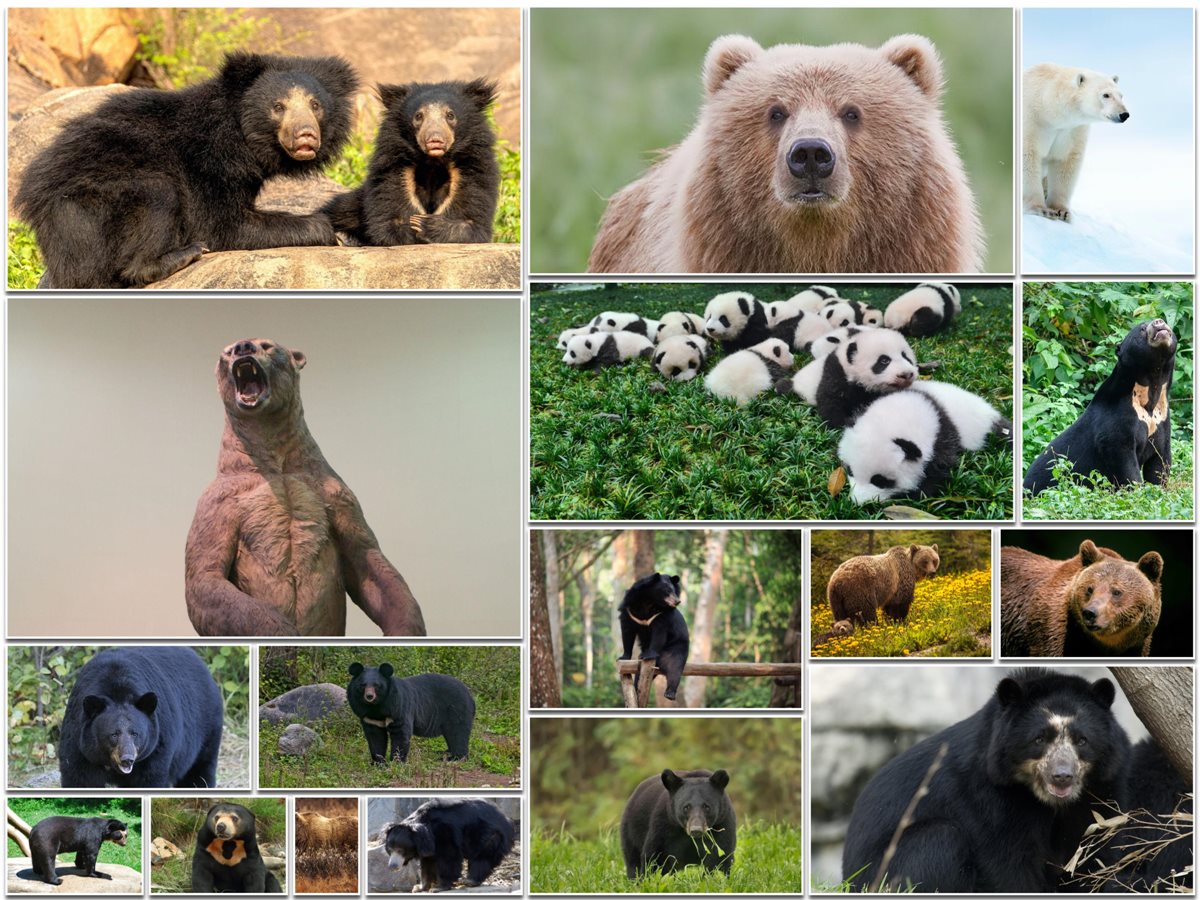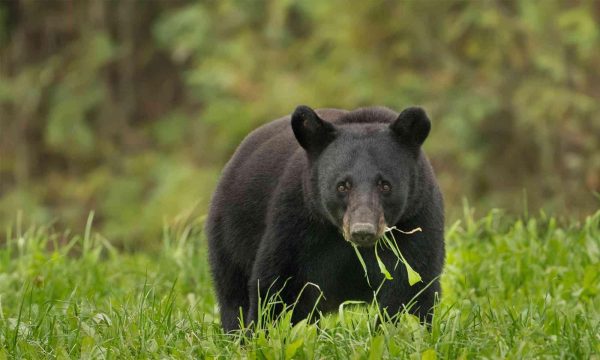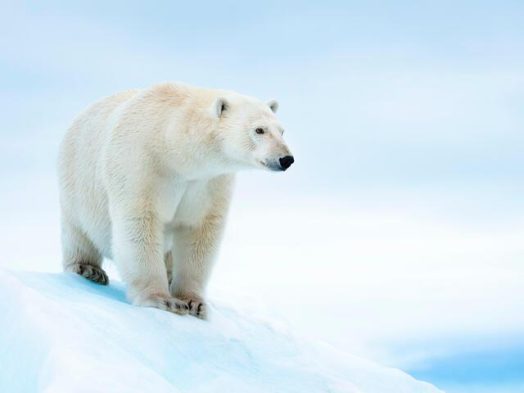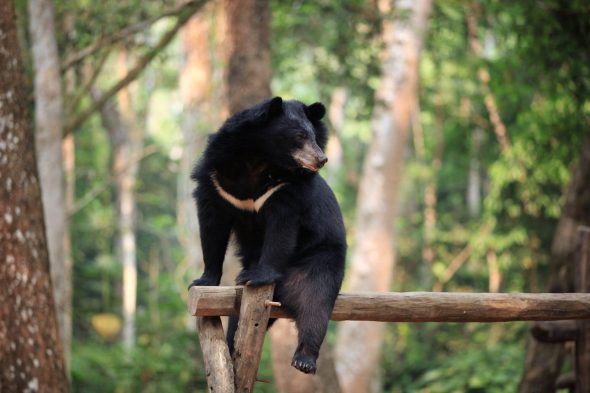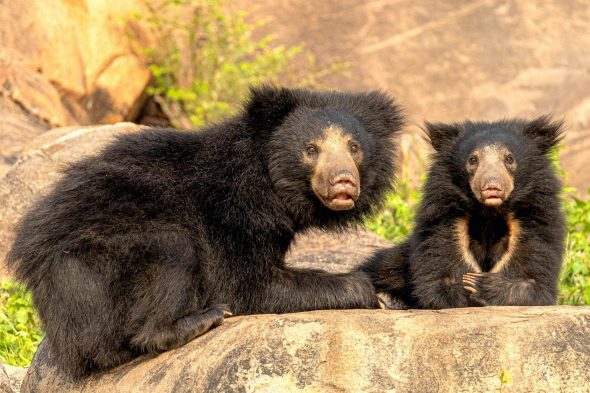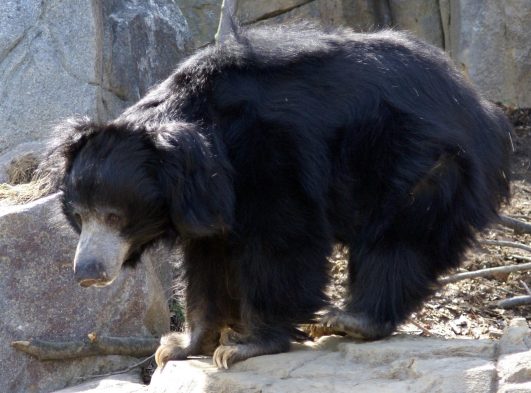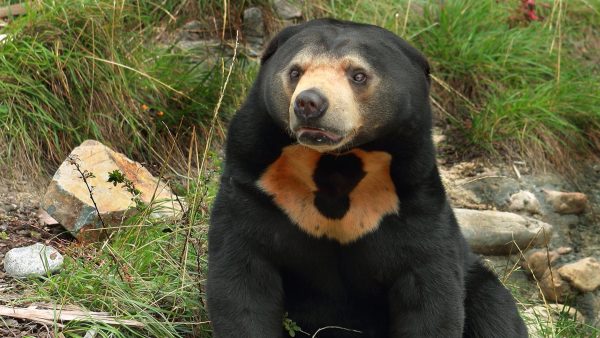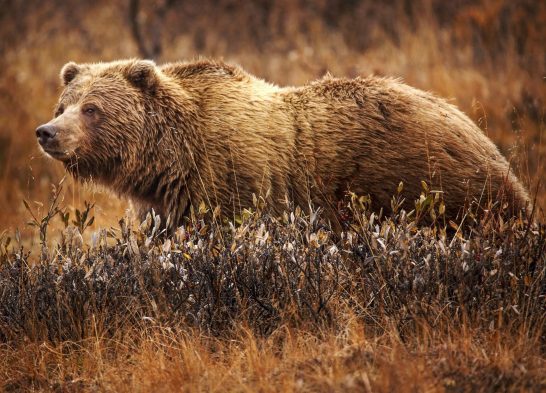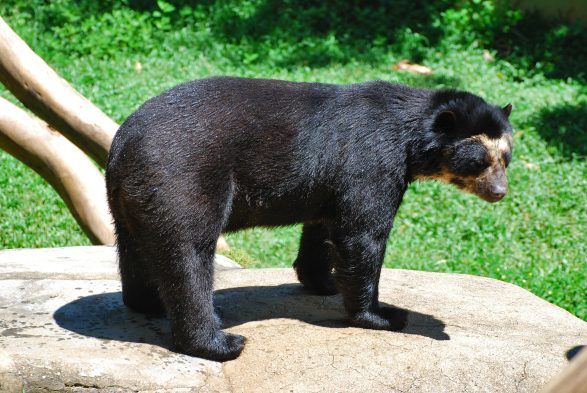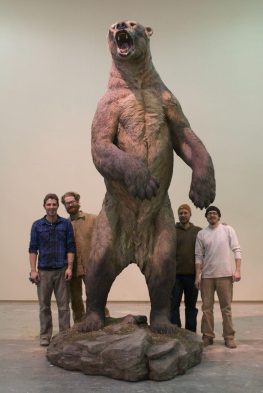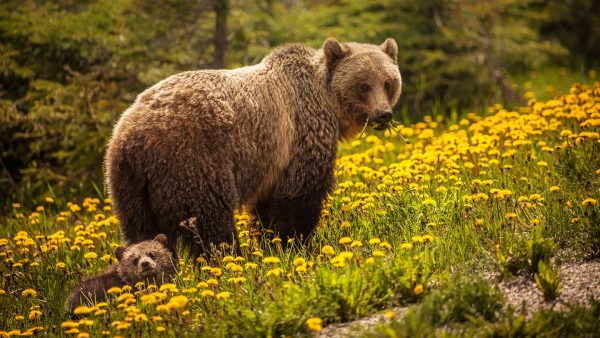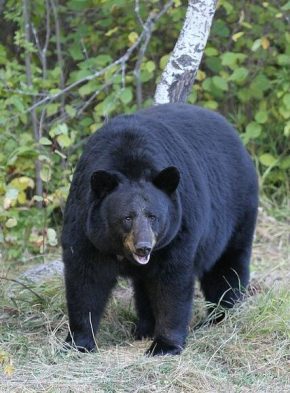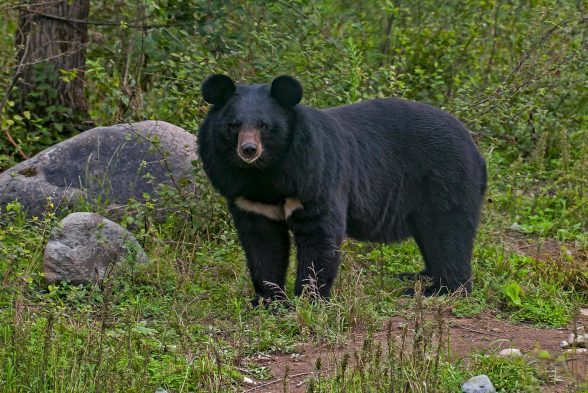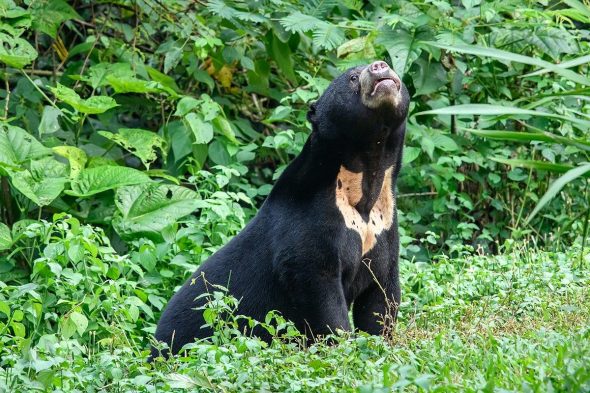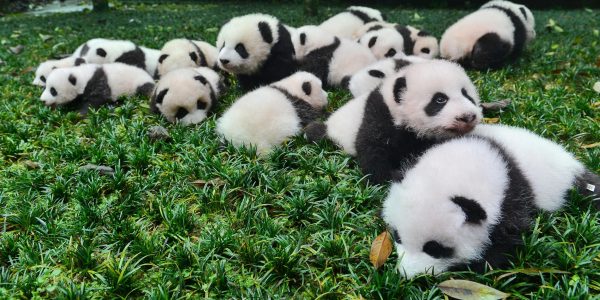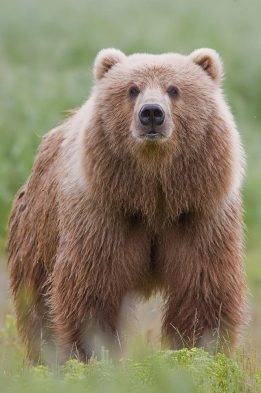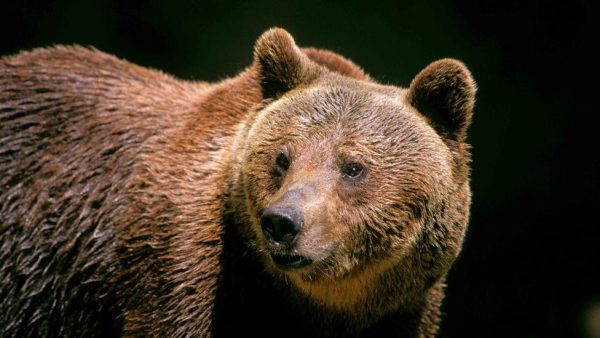Bears are mostly carnivorous animals that belong to the Ursidae family. The term “bear” comes from the Old English word “bear,” which meaning “brown.” They have significant populations in North and South America, Asia, and Europe, and are found all over the planet.
Bears come in eight distinct species and may be found in a variety of environments across the world. Due to hunting, poaching, and illicit trafficking, six bear species are endangered or vulnerable.
Shaggy hair, clawed paws, short tails, big snouts, stocky legs, and tiny rounded ears define the majority of them. They have a keen sense of smell and are mostly active at night.
Despite their hefty and ungainly build, they are excellent climbers, swimmers, and runners as a species. During the winter, most bear species hibernate for 100 days in shelters like dens.
Different Types of Bears
Here is the latest list of all types of bears that you should know about.
1. North American Black Bear
The North American Black Bear is the most common bear in North America, with populations spanning from Florida to Canada and Alaska. The black bear’s black and brown color phases are prevalent. The white color phase is relatively uncommon in Canada’s northwestern British Columbia. The black bear eats everything. Vegetables make up the majority of their diet. Males achieve full growth around the age of eight. Females in boreal forest zones mate and have cubs at the age of 5 to 7 years, and at the age of 8 years and older (Ontario). Males may weigh up to 280kg (600 pounds) and sometimes even more. In the wild, black bears can live up to 25 years. Although older bears have been reported, the bulk of bears never reach old age (hunting) due to human activities.
2. Brown Bear
Alaska, western Canada, and portions of Washington, Montana, and Wyoming are all home to the Brown Bear. Small, isolated populations can be found across Europe and Asia. Brown bears are now in good numbers in Russia. Brown bears can be virtually black, brown, or extremely light brown or blonde in color. Size fluctuates a lot depending on where you live and how much food is available. The biggest bears, known as “Big Browns,” live near the coasts of Alaska and Russia, reaching proportions that match those of the Polar Bear. Interior bears in the Rocky Mountains of North America (Grizzly Bear) and European mountains are significantly smaller. Bears that weigh 1500 pounds/700 kilogrammes or more are becoming increasingly rare.
3. Polar Bear
Ursus Maritimus (Marine Ursus) Polar bears are among the world’s biggest bears. Adult males can weigh up to 800 kilogrammes (1760 pounds) (lbs). The heaviest male bear documented in “live capture” research investigations in Ontario weighed 654 kg (1439 lbs). Male polar bears in Ontario weigh around 500 kg on average (1100 lbs). Adult female bears are smaller, weighing approximately 300 kg (660 lbs) on average, with peak weights seldom exceeding 400 kg (880 lbs).
4. Asiatic Black Bear
Ursus thibetanus, Himalayan black bear, moon bear Long black fur with a crescent-shaped white patch on the chest distinguishes Asiatic black bears. Their ears are big and their fur around the shoulders and throat is very lengthy.
Afghanistan, Bangladesh, Bhutan, Cambodia, China, India, Islamic Republic of Iran, Japan, Democratic People’s Republic of Korea, Lao People’s Democratic Republic, Malaysia, Mongolia, Myanmar, Nepal, Pakistan, Russian Federation, Taiwan, and Vietnam are all home to Asiatic black bears.
Although meat makes up a minor percentage of their diet, Asiatic black bears are more carnivorous than their American counterparts. Small animals, birds, fish, mollusks, and corpses are all included. They eat grasses, fruits, berries, seeds, insects, and honey, among other things. They bulk up for the winter by eating nuts in the autumn. They hibernate in northern climates. They do not hibernate in southern climates.
5. Andean Bear or Spectacled Bear
Tremarctos ornatus is a species of Tremarctos. Spectacled bears are also known as Andean bears by most biologists (they are found only in the Andes mountains in South America). It is prohibited to kill bears since they are an endangered species classified as Vulnerable. The Andean bear (subfamily Tremarctinae) is the only extant short-faced bear (subfamily Tremarctinae) and the closest living relative of the Florida spectacled bear and other Middle Pleistocene to Late Pleistocene short-faced bears.
Spectacled bears are the only remaining bear species endemic to South America and the sole surviving member of the Tremarctinae subfamily. Although meat makes up just around 5% of the Spectacled Bear’s diet, it is officially the continent’s greatest land carnivore. The jaguar is South America’s biggest obligate carnivore.
Only the Baird’s and South American Tapirs are heavier than this species among South America’s living native land mammals. The Spectacled bear is a medium-sized bear species. Bears’ fur is generally blackish in color, however it can range from jet black to dark brown and even reddish.
Although not all Spectacled bears have “spectacle” markings, they do have unique beige-colored patterns over their face and upper chest. Each bear’s pattern and amount of pale markings varies slightly, and this allows bears to be easily identified. Males are a third bigger in size and weigh up to twice as much as females. Males may weigh between 100 and 200 kilogrammes (220 and 440 pounds), while females can weigh between 35 and 82 kilogrammes (77 and 181 pounds).
The length can range from 120 to 200 cm (47″79 in), with a tail that is just 7 cm (2.8 in) long and a shoulder height of 60 to 90 cm (24″30 in). This species has a more rounded face than other extant bears and a short and wide nose. Despite the herbivorous diet of current Spectacled bears, this facial feature has been believed to represent an adaptation to a primarily carnivorous diet in some extinct Tremarctinae subfamily species.
6. Sloth Bear
Sloth bears (Melursus ursinus) are primarily found in wooded regions and grasslands in Bangladesh, Nepal, and Bhutan, though they were once more widespread in India and Sri Lanka. They feature long, shaggy black coats that are thought to suggest vulnerability to cold stress, as well as long snouts like those of anteaters. Females generally weigh between 120 and 200 pounds, while males range between 176 and 300 pounds.
With a moniker like sloth bear, one might expect these nocturnal bears to be lethargic and sluggish, but the reverse is true. Sloth bears can gallop faster than most people because of their huge feet and big claws in contrast to the rest of their body. On the other hand, early explorers observed black bears hanging upside down in trees and gave it the name (they are excellent climbers). They are also thought to be the first dancing bears, as there are historical reports of nomadic people in India teaching sloth bears to perform and entertain crowds.
7. Sloth Bear”Melursus (Ursus) Ursinus
Long distances may be heard these shaggy-haired bears slurping up insects. Sloth bears have a white U- or Y-shaped marking on their chest and long, shaggy black hair. They have big lips, a long tongue, a pale snout, and well-developed hook-like claws for climbing trees and digging for termites. Sri Lanka, India, Bhutan, Nepal, and Bangladesh are all home to sloth bears. Sloth bears are nocturnal and live in home ranges with other sloth bears that they appear to enjoy sharing.
Male sloth bears have a 13-square-kilometer range on average. This bear is significantly smaller than most others because they do not experience seasonal food supply variations (ants and termites are available all year round). Ants and termites do not need to hibernate during the winter since they are always available.
8. Sun Bear
They are the tiniest bear species. Sun bears have short, water-repellent black/dark brown fur with a yellow crescent on their breast. They have long sickle-shaped claws and powerful paws with no soles. They have long tongues and flexible snouts, which are adaptations for removing termites from nests. They have the biggest canines of any bear species when compared to their size. Sun bears have canine teeth that are designed for ripping flesh, although they aren’t very carnivorous. They may use their razor-sharp teeth as weapons or to rip trees down to get at insects. Sun bears may be found in Brunei Darussalam, Cambodia, China, India, Indonesia, Lao Peoples Democratic Republic, Malaysia, Myanmar, Thailand, and Vietnam in Southeast Asia.
9. Grizzly Bear
The grizzly bear is a brown bear subspecies found in North America. Grizzlies are dark in color, but their fur can seem white-tipped, or grizzled, which gives them their name. Grizzly bears are legally protected in the continental United States, but not in Alaska, despite several controversial attempts to repeal such protections in recent years. They may weigh up to 800 pounds and, with the exception of mothers and their pups, are solitary creatures. Grizzly bears are top-of-the-food-chain predators with enormous strength.
Nuts, berries, fruit, leaves, and roots make up a large part of their diet. Bears consume a variety of species, including rodents and moose. Grizzlies have been seen running at speeds of up to 30 miles per hour, despite their enormous size. These creatures require a large amount of space, with a home range of up to 600 square miles. The number of grizzly bears has risen under the protection of the US Endangered Species Act since 1975, when they were classified as endangered.
10. Andean Bear
The spectacled Andean bear is the only bear species found in South America. Due to habitat loss, it has an uncertain future. These bears are really strong climbers. Spectacled bears are timid, gentle, and elusive, preferring to avoid human interaction. They are generally solitary, but when favoured food items are plentiful, they can be found in rather high quantities. Most places’ population numbers have recently been considered to be modest, with the Northern Andes’ overall population believed to be between 6,000 and 10,000 people. Hunting and habitat loss and degradation are the primary threats to spectacled bears in the region.
11. Short-Faced Bear
The first thing you should know about the Short-Faced bear is that it is no longer alive. The short-faced bear was the biggest and most powerful land carnivore in North America during the ice age. It might have weighed several thousand pounds and stood at least 11 feet tall when upright. According to experts, the short-faced bear, also known as the fastest moving bear that ever lived, inhabited the planet between 500,000 and 2 million years ago and would have been the largest and most powerful meat-eater on land at the time.
12. Asiatic Black Bear
Asiatic Black bears are medium-sized and black in hue, with a light-colored snout and ears. Asiatic black bears are mostly found in wooded regions, particularly in hills and hilly places in southern Asia. Bears sleep in dens in the northern regions of their habitat during the winter. Fruits, bees’ nests, insects, invertebrates, small vertebrates, and carrion have all been documented as being eaten by Asiatic black bears. They feed on domestic cattle from time to time, although the extent to which they prey on wild hoofed animals is unclear. The International Union for Conservation of Nature and Natural Resources has classified the Asiatic black bear as vulnerable (IUCN).
13. Brown Bear
Brown bears may be found in northern North America, Europe, and Asia’s woods and mountains. Except for mothers and their babies, these omnivorous giants are typically solitary creatures, but they do occasionally cluster. When the salmon travel upstream for summer spawning, dramatic crowds may be witnessed at Alaskan fishing locations. During this time of year, hundreds of brown bears may congregate to feed on the salmon.
A brown bear in the fall may eat up to 90 pounds of food each day and weigh twice as much as it does in the spring before hibernating. While being top-of-the-food-chain carnivores, Brown bears eat a lot of nuts, berries, fruit, leaves, and roots. Brown bears, like other subspecies, consume a variety of animals, from rodents to moose. Brown bears, despite their large size, are incredibly quick, reaching speeds of 30 mph.
14. American Black Bear
The American Black Bear is a medium-sized bear that is endemic to North America. They are omnivores and are extensively dispersed throughout the region. Their diets might differ depending on where they are and what season it is. They dwell in the woods, although they may go out for food. The American black bear is the most abundant bear species, and it is classified as a least concern species by the International Union for Conservation of Nature (IUCN). It’s one of just two bear species that aren’t on the verge of extinction. They use their claws and teeth to brand trees in order to communicate with other bears.
15. Asian Black Bear
Because of its white breast, the Asian black bear is also known as the moon bear. They’re medium-sized and come from Asia. The Himalayas, Northeastern China, Korea, Northern India, Japan’s islands, Taiwan, and Far East Russia are all home to them.
Because to poaching and deforestation, they are classed as vulnerable. They look a lot like prehistoric bears and are the progenitor of many bear species. They are mostly herbivores, but have learnt to be hostile toward humans who attempt to kill or capture them.
16. Malayan Sun Bears
The Malayan Sun Bear is found in Southeast Asia’s tropical woodlands. They’ve been designated as vulnerable because their worldwide population has shrunk by 30% in only three bear generations. This is due to hunting and extensive deforestation, which has resulted in habitat and food loss. Because of its fondness for honey, bees, and honeycomb as food, the Sun bear is also known as the Honey bear.
They also eat insects and fruits, which they can readily discover because of their keen sense of smell. They are diurnal species who sleep for most of the day and do not hibernate. They are sociable creatures in captivity, but they may be extremely violent if surprised in the wild.
17. Giant Panda
South Central China is home to the Giant Panda. It’s a big bear with black spots around the ear, eyes, and all over its body. According to estimates, there are between 2000 and 3000 pandas on the planet. One of the primary causes contributing to their endangered status is their food, which consists entirely of bamboo (it has been changed to vulnerable due to global conservation efforts).
Deforestation of bamboo trees resulted in a lack of food, which severely influenced the Giant Panda population. It can also consume grass and, on rare occasions, meat. Fish, eggs, leaves, oranges, bananas, honey, and other carefully prepared meals are available to them in captivity. They are primarily found in central China’s mountain ranges or in captivity across the world.
18. Kodiak Brown Bear
The Alaskan brown bear is another name for the Kodiak brown bear. They are mostly found in the Kodiak Archipelago in Alaska’s southwest area. They have a diet and appearance similar to American brown bears, although they are smaller.
They are twice the size of American brown bears, weighing between 300 and 600 kg. It is popular to hunt them for their flesh and fur, which has resulted in conservation initiatives. As a result of these efforts, they have been categorised as a species of least concern. The Alaska Department of Fish and Game keeps a close eye on their growth.
19. Marsican Brown Bear
The Marsican brown bear is highly endangered and only found in a limited area of Italy’s Abruzzo National Park and surrounding territories. Only around 50 bears exist on the globe, and they live in solitude. They have a peaceful demeanour and exhibit no symptoms of aggressiveness when it comes to people. a They are bigger than other bear subspecies, with males weighing up to 217 kg and females weighing around 140 kg on average. They consume berries primarily, but they do have small animals such as chickens on occasion.
They are occasionally observed rolling over rocks in search of insects, and their keen sense of smell aids them in their hunt. During their hibernating nap, they wake up many times.
